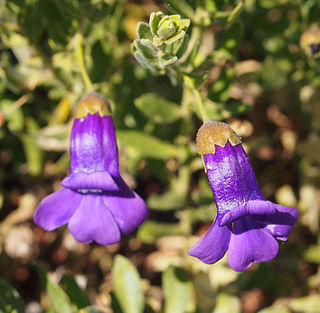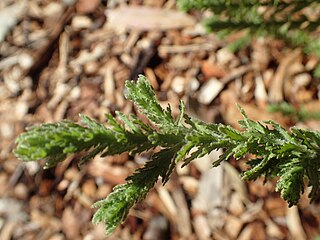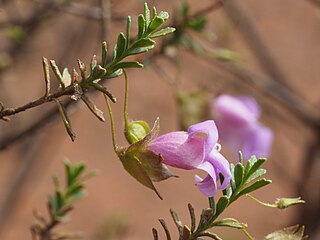
Eremophila hygrophana is a flowering plant in the figwort family, Scrophulariaceae and is endemic to Australia. It is an erect, compact shrub with crowded, grey leaves and violet to purple flowers and is native to South Australia and Western Australia.

Eremophila macdonnellii, also known as MacDonnell's desert fuchsia, is a flowering plant in the figwort family, Scrophulariaceae and is endemic to Australia. It is a shrub with many tangled branches, which, along with the leaves, are often covered with many, sometimes long hairs. The flowers are deep violet or purple, and the species is widespread in Central Australia.

Eremophila incisa is a flowering plant in the figwort family, Scrophulariaceae and is endemic to Western Australia. It is a low shrub with shiny leaves which have thickened teeth along their edges and hairy, mauve or purple flowers.
Eremophila oblonga is a flowering plant in the figwort family, Scrophulariaceae and is endemic to Western Australia. It is a small, domed-shaped shrub with small, fleshy leaves and purple or mauve flowers growing near Balladonia.

Eremophila obovata is a flowering plant in the figwort family, Scrophulariaceae and is endemic to Australia. It is a low, compact shrub with lilac to purple flowers growing mainly in the Northern Territory and Queensland but also Western Australia, South Australia and New South Wales.

Eremophila occidens is a flowering plant in the figwort family, Scrophulariaceae and is endemic to Western Australia. It is a slender, erect shrub with branches that are hairy at first, light green leaves crowded at the ends of the branches and purple to deep violet flowers in early Spring. It is restricted to the extreme west of Western Australia.
Eremophila pallida is a flowering plant in the figwort family, Scrophulariaceae and is endemic to Western Australia. It is a small, spreading shrub with hairy stems, leaves with a few serrations and reddish purple to violet flowers.
Eremophila pendulina is a flowering plant in the figwort family, Scrophulariaceae and is endemic to Western Australia. It is a tall, spindly, weeping shrub with narrow leaves and purple, mauve or white flowers in autumn and early spring.

Eremophila pinnatifida, commonly known as Dalwallinu eremophila is a flowering plant in the figwort family, Scrophulariaceae and is endemic to Western Australia. It is a spreading, rounded shrub with aromatic, deeply divided leaves and pale purple flowers which are white with purple spots inside. It is a rare plant, known only from a few areas near Perth.
Eremophila praecox is a flowering plant in the figwort family, Scrophulariaceae and is endemic to Australia. It is a small, broom-like shrub with small leaves and purple and white flowers.

Eremophila punctata is a flowering plant in the figwort family, Scrophulariaceae and is endemic to Western Australia. It is an erect shrub with sticky young branches and leaves due to the presence of resin. Its small leaves usually have a few blunt teeth near their ends and flowers which are usually lilac-coloured. It is a distinctive and widespread species.
Eremophila pungens is a flowering plant in the figwort family, Scrophulariaceae and is endemic to Australia. It is an erect, sticky shrub with broad, serrated-edged leaves which end in a sharp spine and purple or violet flowers.
Eremophila retropila is a flowering plant in the figwort family, Scrophulariaceae and is endemic to Western Australia. It is an erect, spreading shrub with hairy, greyish leaves crowded at the ends of the branches, and lilac or violet-coloured flowers which are white inside.
Eremophila revoluta is a flowering plant in the figwort family, Scrophulariaceae and is endemic to Western Australia. It is a low, dense shrub with small, hairy leaves, very hairy sepals and mauve or purple petals.

Eremophila rhegos is a flowering plant in the figwort family, Scrophulariaceae and is endemic to Western Australia. It is an erect shrub with densely hairy leaves and branches and blue, mauve, purple or white flowers.

Eremophila rotundifolia is a flowering plant in the figwort family, Scrophulariaceae and is endemic to Australia. It is a shrub with many tangled branches with its leaves and branches covered with a layer of silvery-grey hairs. Its flowers range in colour from pale to deep lilac. It is common in South Australia and there is also a single record from the Northern Territory.
Eremophila shonae is a flowering plant in the figwort family, Scrophulariaceae and is endemic to Western Australia. It is an erect shrub or a low spreading shrub, depending on subspecies and has very sticky branches and leaves due to the presence of large amounts of resin. The leaves are narrow and the flowers are mauve to purple and white inside with purple spots.
Eremophila simulans is a flowering plant in the figwort family, Scrophulariaceae and is endemic to Western Australia. It is an erect shrub with broad, serrated leaves and violet to purple flowers.

Eremophila spathulata, commonly known as spoon-leaved eremophila, is a flowering plant in the figwort family, Scrophulariaceae and is endemic to Western Australia. It is a shrub with many tangled branches, stiff, grey, spoon-shaped leaves, reddish-purple sepals and blue, pink or violet petals.

Eremophila spectabilis, commonly known as showy poverty bush, is a flowering plant in the figwort family, Scrophulariaceae and is endemic to Western Australia. It is a dense, erect shrub with narrow, greyish leaves and blue, mauve or purple flowers.












